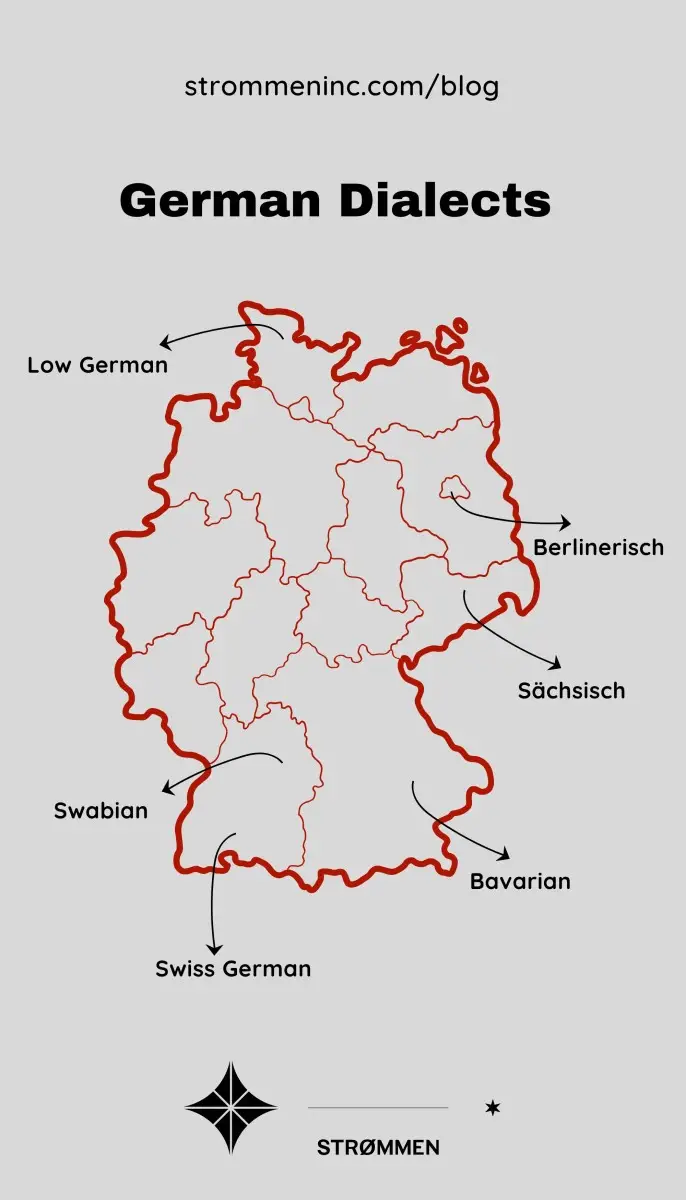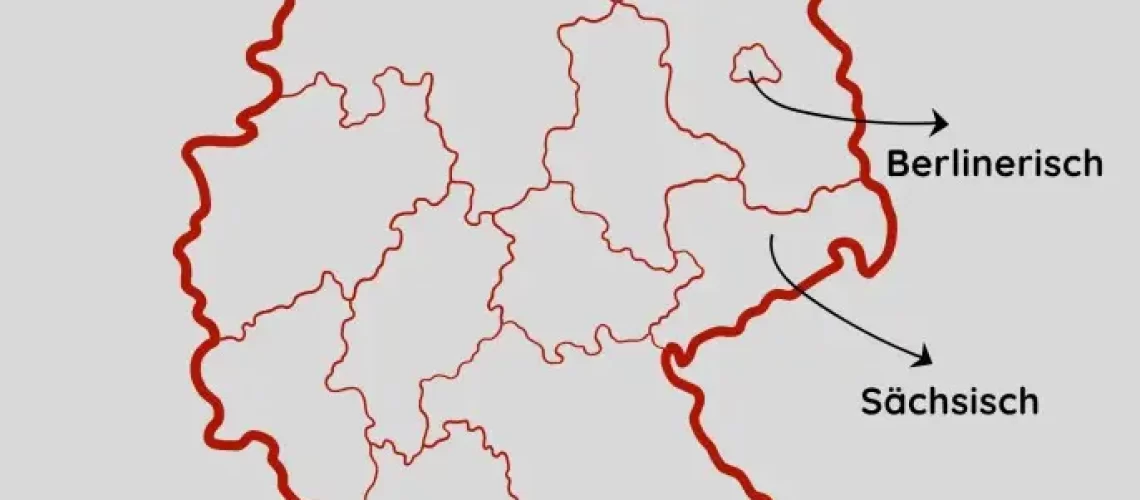German is renowned as the language of poets and thinkers, but it also represents a wide range of regional voices. From the melodious lilt of Swiss German to the clipped tones of Berlin, German dialects are as diverse as the locations from which they originate. While most students begin with Hochdeutsch (Standard German), you’ll quickly discover that locals don’t always speak the way you hear in textbooks.
Understanding these dialects is more than just talking; it’s about culture, history, and identity. Each one carries traditions, regional pride, and unique characteristics that make German so intriguing to study. In this guide, we’ll walk you through the most prominent German dialects, explain how they differ, and give you advice on what matters most to learners.
Whether you’re just getting started with German or have been practicing with native speakers for a while, exploring dialects is a terrific way to appreciate the language’s complexity and connect more deeply with the people who speak it.
What is a German Dialect vs. Accent?
When people talk about German dialects and German accents, they often mix the two up, but they’re not quite the same thing.
A dialect is a regional variant of German with its own vocabulary, grammar, and accent. Dialects can differ so much from Standard German (Hochdeutsch) that even native speakers from other regions may fail to understand them. Swiss German, for example, is classified as a dialect, but many Germans regard it as a different language due to its unique characteristics.
In contrast, an accent is entirely about pronunciation. Someone may speak flawless Hochdeutsch, but with a regional accent that indicates where they grew up. A Berliner speaking Standard German, for example, may pronounce some sounds differently than a Bavarian, despite the fact that they use the same language and vocabulary.
For language learners, this distinction matters. Dialects can introduce entirely new words and structures, while accents are mostly about sound. That’s why most students focus first on Standard German, it gives you a solid base. From there, you’ll naturally start recognizing the accents and dialects that make German such a colorful, varied language.

Hochdeutsch – Standard German
If you’ve ever opened a German textbook, listened to a news broadcast from Berlin, or taken a German lesson, you’ve probably encountered Hochdeutsch, commonly known as Standard German. This is the type of language taught in schools, used in official documents, and broadcast on national television and radio. Consider it the “neutral” variety of German, designed to be understandable in all German-speaking regions.
Unlike some regional dialects, Hochdeutsch is relatively uniform. Its pronunciation, grammar, and vocabulary are standardized, making it the go-to choice for business, academia, and communication between people from different parts of Germany, Austria, and Switzerland.
For learners, this is excellent news. Hochdeutsch is the foundation of most German courses because it gives you the tools to be understood anywhere in the German-speaking world. Even though locals may switch into their dialects at home or among friends, nearly everyone can and does use Standard German when needed.
That said, Hochdeutsch isn’t completely without regional flavor. Someone from Hamburg and someone from Munich might both speak Standard German, but their accents can reveal where they’re from. Still, as a learner, mastering Hochdeutsch first is the best way to ensure clear communication, no matter which corner of the German-speaking world you visit.
Major Dialects in Germany
Germany may look compact on a map, but step off the train in a new city and you might feel like you’ve landed in a different linguistic world. From the sing-song tones of Saxony to the hearty sounds of Bavaria, German dialects reveal just how diverse the language really is. While Standard German (Hochdeutsch) unites speakers across regions, local dialects carry deep cultural roots and can sometimes sound worlds apart from what you’ll find in textbooks.
Berlinerisch – Berlin Dialect
Berlinerisch is the lively dialect of Germany’s capital, known for its dropped sounds and playful slang. It reflects Berlin’s edgy, humorous, and multicultural character. While many locals speak Standard German in formal situations, Berlinerisch shines in casual conversation.
- Region: Berlin and surrounding Brandenburg.
- Influences: Central German dialects, Yiddish, and immigrant languages.
- Interesting Fact: A classic Berlinerisch greeting is “Na, allet klar?” (Hey, everything good?), showing the city’s informal vibe.
Sächsisch – Saxon German
Sächsisch is spoken in Saxony and is one of Germany’s most recognizable (and sometimes polarizing) dialects. It has a melodic rhythm, softened consonants, and unique vowel sounds. While some Germans poke fun at it, locals are proud of their distinctive way of speaking.
- Region: Saxony, especially Dresden, Leipzig, and Chemnitz.
- Influences: Central German dialects with historical Slavic language contact
- Interesting Fact: Sächsisch was once considered prestigious, during the Renaissance, Saxony was a cultural and political center of Germany.
Bavarian (Bairisch)
Bavarian German is strongly tied to cultural traditions, Oktoberfest, and folk music. It features rolled “r” sounds, shortened vowels, and unique greetings like “Servus” and “Grüß Gott.” Even native Germans from outside Bavaria sometimes struggle to follow it.
- Region: Bavaria (southeastern Germany) and parts of Austria.
- Influences: Old High German and neighboring Austrian dialects.
- Interesting Fact: Bavarian is so distinct that many linguists classify it as its own dialect group rather than just a regional accent.
Swabian (Schwäbisch)
Swabian has a reputation for being warm, friendly, and musical. Words often end with “-le” as a diminutive (like Häusle for “little house”). Locals in Baden-Württemberg take great pride in this dialect, which outsiders sometimes find charming but hard to understand.
- Region: Stuttgart and surrounding areas in Baden-Württemberg.
- Influences: Alemannic dialect family.
- Interesting Fact: Swabians are stereotypically associated with thriftiness, and their dialect even reflects this; many words are shortened compared to Hochdeutsch.
Swiss German (Schweizerdeutsch)
Swiss German is actually a collection of Alemannic dialects spoken across Switzerland. It differs so much from Standard German that even Germans from outside Switzerland can struggle to follow. It has its own vocabulary, pronunciation, and even grammar quirks.
- Region: German-speaking parts of Switzerland.
- Influences: Alemannic dialects, French, and Italian.
- Interesting Fact: Swiss German is rarely written down; instead, Swiss people use Standard German for writing and Swiss German for speaking.
Low German (Plattdeutsch / Niederdeutsch)
Low German is a northern dialect historically closer to Dutch and English than to Standard German. It once served as the language of the Hanseatic League and remains an important part of northern Germany’s cultural heritage. Today, it’s more often heard among older generations.
- Region: Northern Germany, especially Lower Saxony, Bremen, and Hamburg.
- Influences: Old Saxon and Dutch.
- Interesting Fact: Plattdeutsch nearly disappeared in the 20th century, but revival efforts in schools and media are helping keep it alive.
Which Dialect Should Language Learners Focus On?
With so many different German dialects, it’s normal for learners to question which one to study first. The quick answer is simple: Hochdeutsch (standard German).
Hochdeutsch is the basis for education, media, and government communication in Germany, Austria, and Switzerland. It is used in textbooks, language classes, and news broadcasts, and it ensures that you are understood wherever you travel in the German-speaking globe.
Once you’ve gained comfort in Standard German, you’ll notice dialects everywhere, whether it’s a Berliner missing consonants, a Bavarian greeting you with “Servus,” or a Swiss speaker utilizing a completely new lexicon. At that point, learning to distinguish dialects becomes a fascinating method to connect deeper with local culture rather than a barrier to conversation.
Tips for learners:
- Start with Standard German: It’s your ticket to clarity and mutual understanding everywhere.
- Listen for regional accents: Even in Hochdeutsch, pronunciation varies by region. Training your ear helps you adapt quickly.
- Treat dialects as cultural insight: Think of them as bonus knowledge that deepens your appreciation of German, rather than something you need to master right away.
In other words: master Hochdeutsch first, and let dialects enrich your journey as you go.
How Strommen Teaches German Dialects
At Strommen, we know that learning German isn’t just about mastering grammar rules or memorizing vocabulary lists, it’s about connecting with people. And since people rarely stick to textbook German in everyday life, our tutors go beyond Hochdeutsch to introduce you to the dialects and accents that bring the language to life.
Here’s how we do it:
- Native Speakers from Different Regions: Our tutors come from across Germany, Austria, and Switzerland, so you’ll hear authentic dialects straight from the source. Want to get comfortable with Swiss German? Or curious about the unique flair of Berlinerisch? We’ve got you covered.
- Practical, Learner-Friendly Approach: While you’ll always build your foundation in Standard German, our tutors weave in dialectal expressions, regional pronunciation tips, and real-world examples so you won’t feel lost when locals speak naturally.
- Cultural Immersion: Dialects aren’t just about words; they’re about culture. That’s why our lessons include songs, films, and everyday expressions from different regions, giving you a deeper understanding of how German is really spoken.
By learning with Strommen, you won’t just speak German, you’ll understand it in all its colorful variety. Whether your goal is clear communication or cultural immersion, we’ll help you feel confident navigating both Standard German and the dialects that make the language so rich.
Final Thoughts: The Richness of German Dialects
German isn’t just one language; it’s a tapestry of voices, each with its own rhythm, history, and personality. From the clarity of Hochdeutsch to the playful slang of Berlinerisch, the sing-song tones of Sächsisch, the hearty charm of Bavarian, and the distinct sound of Swiss German. Every dialect adds a new layer to the story of how German is spoken today.
For learners, the key takeaway is simple: focus on Standard German as your foundation, and let dialects be an adventure you grow into. Even if you never aim to master them, being aware of regional varieties helps you connect more deeply with locals and better understand the culture behind the language.
Whether you’re planning a trip to Germany, chatting with a tutor, or just curious about the many ways German can sound, exploring dialects is a reminder that language is living, breathing, and full of character.
Are you ready to start learning German dialects? Contact us for a consultation with our learning experts, or find a tutor near you!




